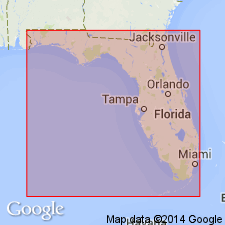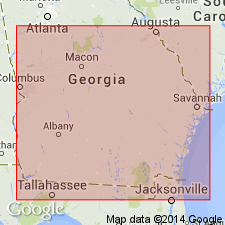
- Usage in publication:
-
- Silver Bluff formation
- Modifications:
-
- First used
- AAPG geologic province:
-
- Florida platform
Summary:
Name Silver Bluff Formation appears on chart only. Overlies Pamlico Formation and underlies Lake Flirt Marl. Age shown as Pleistocene.
Source: GNU records (USGS DDS-6; Reston GNULEX).

- Usage in publication:
-
- Silver Bluff terrace
- Modifications:
-
- Revised
- AAPG geologic province:
-
- South GA-North FL sedimentary province
- Atlantic Coast basin
Summary:
Concept of Silver Bluff Formation is invalid and should be abandoned in the lithostratigraphic sense along with Talbot, Princess Anne, Pamlico, Penholoway, Wicomico, Sunderland, Coharie, and Brandywine Formations. Name is retained as a terrace. Satilla Formation (reinstated and redefined) directly underlies the Holocene-Silver Bluff, Princess Anne, and Pamlico terraces. (The Holocene and Silver Bluff represent two distinct coastal construction events but are combined in this study because together they form one marine terrace.)
Source: GNU records (USGS DDS-6; Reston GNULEX).
For more information, please contact Nancy Stamm, Geologic Names Committee Secretary.
Asterisk (*) indicates published by U.S. Geological Survey authors.
"No current usage" (†) implies that a name has been abandoned or has fallen into disuse. Former usage and, if known, replacement name given in parentheses ( ).
Slash (/) indicates name conflicts with nomenclatural guidelines (CSN, 1933; ACSN, 1961, 1970; NACSN, 1983, 2005, 2021). May be explained within brackets ([ ]).

